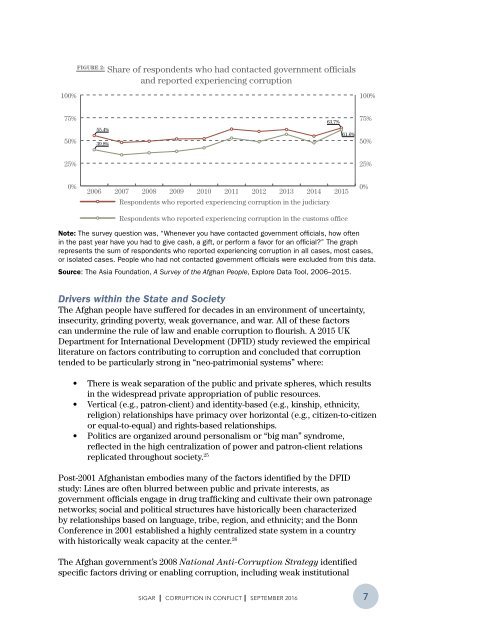CORRUPTION IN CONFLICT
5IlaWjQej
5IlaWjQej
You also want an ePaper? Increase the reach of your titles
YUMPU automatically turns print PDFs into web optimized ePapers that Google loves.
FIGURE 2:<br />
Share of respondents who had contacted government officials<br />
and reported experiencing corruption<br />
100%<br />
100%<br />
75%<br />
50%<br />
55.4%<br />
39.8%<br />
63.7%<br />
61.6%<br />
75%<br />
50%<br />
25%<br />
25%<br />
0%<br />
2006<br />
2007 2008 2009 2010 2011 2012 2013 2014<br />
2015<br />
0%<br />
Respondents who reported experiencing corruption in the judiciary<br />
Respondents who reported experiencing corruption in the customs office<br />
Note: The survey question was, “Whenever you have contacted government officials, how often<br />
in the past year have you had to give cash, a gift, or perform a favor for an official?” The graph<br />
represents the sum of respondents who reported experiencing corruption in all cases, most cases,<br />
or isolated cases. People who had not contacted government officials were excluded from this data.<br />
Source: The Asia Foundation, A Survey of the Afghan People, Explore Data Tool, 2006–2015.<br />
Drivers within the State and Society<br />
The Afghan people have suffered for decades in an environment of uncertainty,<br />
insecurity, grinding poverty, weak governance, and war. All of these factors<br />
can undermine the rule of law and enable corruption to flourish. A 2015 UK<br />
Department for International Development (DFID) study reviewed the empirical<br />
literature on factors contributing to corruption and concluded that corruption<br />
tended to be particularly strong in “neo-patrimonial systems” where:<br />
• There is weak separation of the public and private spheres, which results<br />
in the widespread private appropriation of public resources.<br />
• Vertical (e.g., patron-client) and identity-based (e.g., kinship, ethnicity,<br />
religion) relationships have primacy over horizontal (e.g., citizen-to-citizen<br />
or equal-to-equal) and rights-based relationships.<br />
• Politics are organized around personalism or “big man” syndrome,<br />
reflected in the high centralization of power and patron-client relations<br />
replicated throughout society. 25<br />
Post-2001 Afghanistan embodies many of the factors identified by the DFID<br />
study: Lines are often blurred between public and private interests, as<br />
government officials engage in drug trafficking and cultivate their own patronage<br />
networks; social and political structures have historically been characterized<br />
by relationships based on language, tribe, region, and ethnicity; and the Bonn<br />
Conference in 2001 established a highly centralized state system in a country<br />
with historically weak capacity at the center. 26<br />
The Afghan government’s 2008 National Anti-Corruption Strategy identified<br />
specific factors driving or enabling corruption, including weak institutional<br />
SIGAR I <strong>CORRUPTION</strong> <strong>IN</strong> <strong>CONFLICT</strong> I SEPTEMBER 2016<br />
7


